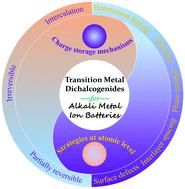当前位置:
X-MOL 学术
›
Energy Environ. Sci.
›
论文详情
Our official English website, www.x-mol.net, welcomes your
feedback! (Note: you will need to create a separate account there.)
Transition metal dichalcogenides for alkali metal ion batteries: engineering strategies at the atomic level
Energy & Environmental Science ( IF 32.4 ) Pub Date : 2020-01-23 , DOI: 10.1039/c9ee03549d Biao Chen 1, 2, 3, 4, 5 , Dongliang Chao 1, 2, 3, 4 , Enzuo Liu 5, 6, 7, 8 , Mietek Jaroniec 9, 10, 11, 12 , Naiqin Zhao 5, 6, 7, 8, 13 , Shi-Zhang Qiao 1, 2, 3, 4
Energy & Environmental Science ( IF 32.4 ) Pub Date : 2020-01-23 , DOI: 10.1039/c9ee03549d Biao Chen 1, 2, 3, 4, 5 , Dongliang Chao 1, 2, 3, 4 , Enzuo Liu 5, 6, 7, 8 , Mietek Jaroniec 9, 10, 11, 12 , Naiqin Zhao 5, 6, 7, 8, 13 , Shi-Zhang Qiao 1, 2, 3, 4
Affiliation

|
In the past few decades, great effort has been made toward the preparation and development of advanced transition metal dichalcogenide (TMD) materials for anodes of alkali metal ion batteries (AMIBs). However, their electrochemical performance is still severely impaired by structural aggregation and fracture during the conversion reaction. To address these issues, various methodologies for the fabrication of hierarchical and hybrid nanostructures, with optimization of materials and electrodes, have been fully investigated and reviewed. As regards tuning the TMD-based materials, extensive efforts have been undertaken toward optimization of their intrinsic structure at the atomic level, including surface defects, interlayer spacing expansion, phase control, alloying, and heteroatom doping. However, the design strategies and methods to manipulate the intrinsic structures and electrochemical mechanisms in AMIBs have not been fully summarized. This review provides a well-timed and critical appraisal of recent advances in the engineering of TMDs at the atomic level for AMIBs, by combining computational and experimental approaches. The correlation between these strategies and electrochemical performance is highlighted. The challenges and opportunities in this research field are also outlined. We expect that this review would be beneficial for improving the overall knowledge on the charge storage mechanisms in TMDs and for pointing out the importance of intrinsic structure engineering for enhancing the performance of TMDs in energy storage.
中文翻译:

碱金属离子电池用过渡金属二卤化物:原子水平的工程策略
在过去的几十年中,人们在制备和开发用于碱金属离子电池(AMIB)阳极的先进过渡金属二卤化双金属(TMD)材料方面付出了巨大的努力。然而,它们的电化学性能仍然由于转化反应过程中的结构聚集和断裂而严重受损。为了解决这些问题,已经充分研究和审查了用于制造分层和混合纳米结构的各种方法,并优化了材料和电极。关于调整基于TMD的材料,已经进行了广泛的努力以优化它们在原子水平上的固有结构,包括表面缺陷,层间间距扩展,相控制,合金化和杂原子掺杂。然而,尚未完全总结操纵AMIBs的固有结构和电化学机理的设计策略和方法。这篇综述通过结合计算和实验方法,对AMIB原子级TMD的工程设计方面的最新进展进行了及时且严格的评估。这些策略与电化学性能之间的相关性得到了强调。还概述了该研究领域中的挑战和机遇。我们希望这次审查将有助于提高对TMDs中电荷存储机制的总体了解,并指出内在结构工程对于增强TMDs在能量存储中的性能的重要性。这篇综述通过结合计算和实验方法,对AMIB原子级TMD的工程设计方面的最新进展进行了及时且严格的评估。这些策略与电化学性能之间的相关性得到了强调。还概述了该研究领域中的挑战和机遇。我们希望这次审查将有助于提高对TMDs中电荷存储机制的总体了解,并指出内在结构工程对于增强TMDs在能量存储中的性能的重要性。这篇综述通过结合计算和实验方法,对AMIB原子级TMD的工程设计方面的最新进展进行了及时且严格的评估。这些策略与电化学性能之间的相关性得到了强调。还概述了该研究领域中的挑战和机遇。我们希望这次审查将有助于提高对TMDs中电荷存储机制的总体了解,并指出内在结构工程对于增强TMDs在能量存储中的性能的重要性。这些策略与电化学性能之间的相关性得到了强调。还概述了该研究领域中的挑战和机遇。我们希望这次审查将有助于提高对TMDs中电荷存储机制的总体了解,并指出内在结构工程对于增强TMDs在能量存储中的性能的重要性。这些策略与电化学性能之间的相关性得到了强调。还概述了该研究领域中的挑战和机遇。我们希望这次审查将有助于提高对TMDs中电荷存储机制的总体了解,并指出内在结构工程对于增强TMDs在能量存储中的性能的重要性。
更新日期:2020-01-23
中文翻译:

碱金属离子电池用过渡金属二卤化物:原子水平的工程策略
在过去的几十年中,人们在制备和开发用于碱金属离子电池(AMIB)阳极的先进过渡金属二卤化双金属(TMD)材料方面付出了巨大的努力。然而,它们的电化学性能仍然由于转化反应过程中的结构聚集和断裂而严重受损。为了解决这些问题,已经充分研究和审查了用于制造分层和混合纳米结构的各种方法,并优化了材料和电极。关于调整基于TMD的材料,已经进行了广泛的努力以优化它们在原子水平上的固有结构,包括表面缺陷,层间间距扩展,相控制,合金化和杂原子掺杂。然而,尚未完全总结操纵AMIBs的固有结构和电化学机理的设计策略和方法。这篇综述通过结合计算和实验方法,对AMIB原子级TMD的工程设计方面的最新进展进行了及时且严格的评估。这些策略与电化学性能之间的相关性得到了强调。还概述了该研究领域中的挑战和机遇。我们希望这次审查将有助于提高对TMDs中电荷存储机制的总体了解,并指出内在结构工程对于增强TMDs在能量存储中的性能的重要性。这篇综述通过结合计算和实验方法,对AMIB原子级TMD的工程设计方面的最新进展进行了及时且严格的评估。这些策略与电化学性能之间的相关性得到了强调。还概述了该研究领域中的挑战和机遇。我们希望这次审查将有助于提高对TMDs中电荷存储机制的总体了解,并指出内在结构工程对于增强TMDs在能量存储中的性能的重要性。这篇综述通过结合计算和实验方法,对AMIB原子级TMD的工程设计方面的最新进展进行了及时且严格的评估。这些策略与电化学性能之间的相关性得到了强调。还概述了该研究领域中的挑战和机遇。我们希望这次审查将有助于提高对TMDs中电荷存储机制的总体了解,并指出内在结构工程对于增强TMDs在能量存储中的性能的重要性。这些策略与电化学性能之间的相关性得到了强调。还概述了该研究领域中的挑战和机遇。我们希望这次审查将有助于提高对TMDs中电荷存储机制的总体了解,并指出内在结构工程对于增强TMDs在能量存储中的性能的重要性。这些策略与电化学性能之间的相关性得到了强调。还概述了该研究领域中的挑战和机遇。我们希望这次审查将有助于提高对TMDs中电荷存储机制的总体了解,并指出内在结构工程对于增强TMDs在能量存储中的性能的重要性。











































 京公网安备 11010802027423号
京公网安备 11010802027423号